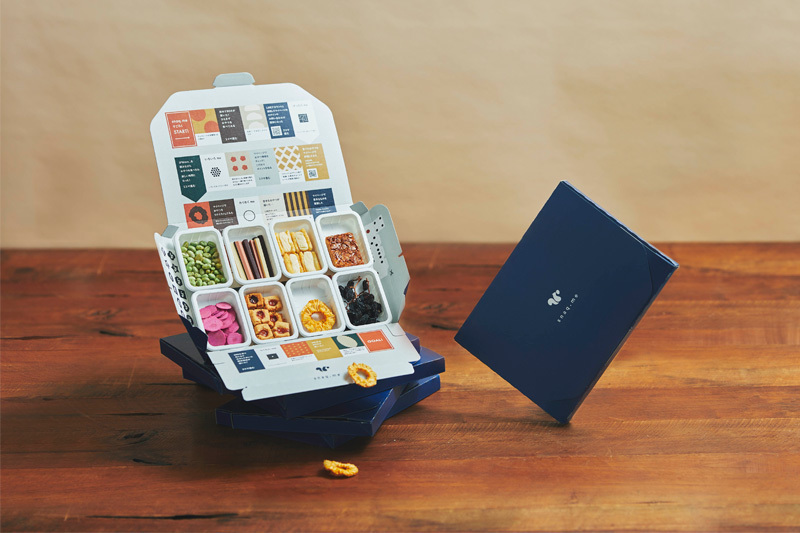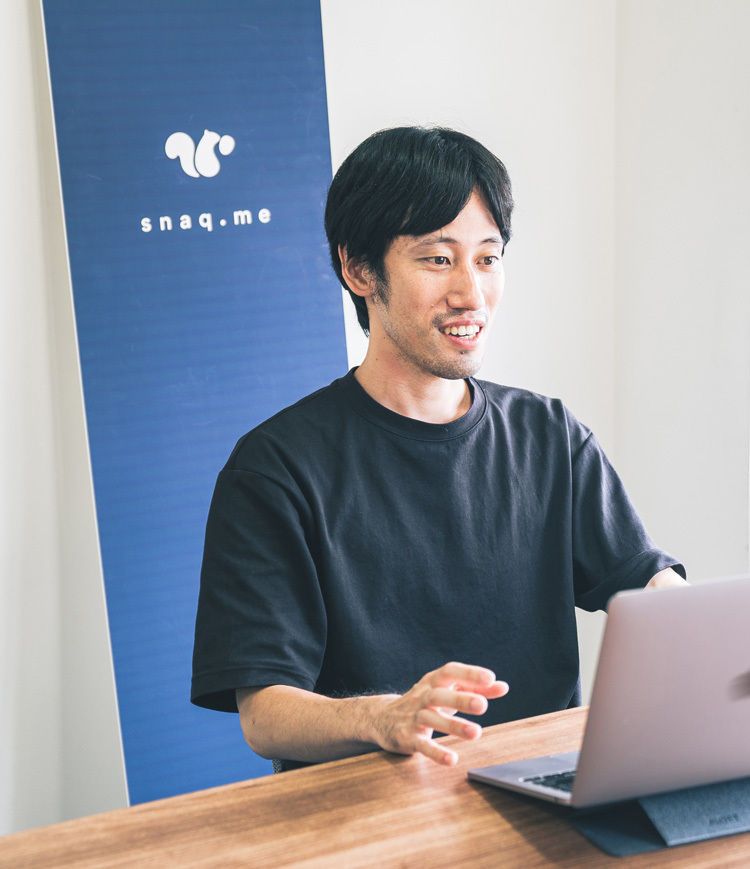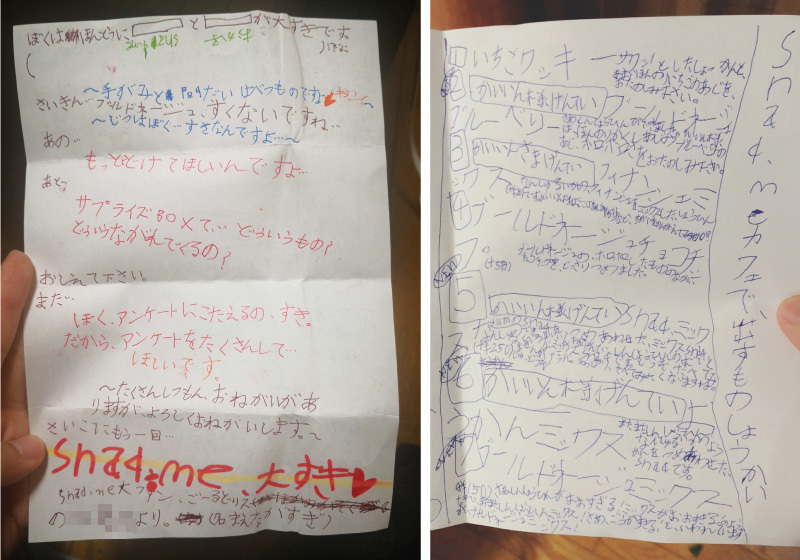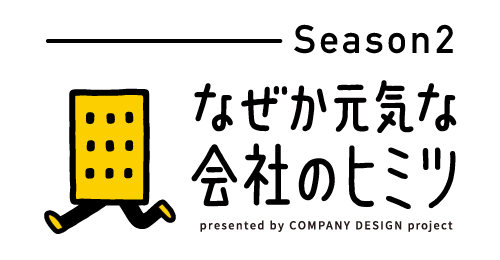Note: This website was automatically translated, so some terms or nuances may not be completely accurate.
A Serious Discussion About the "Snack World"
This series follows Dentsu Inc. 'Company Design' team as they uncover the secrets behind vibrant companies with 'originality.' The eleventh installment features 'snaq.me,' a startup offering a subscription service for snacks. We delve into their flexible creativity, which consistently brings to life services that surprise and delight everyone.
What comes to mind when you hear "the world of sweets"? Is it the gorgeous, glittering world of world-renowned pastry chefs? The elegant world of Kyoto wagashi, inheriting traditional techniques? The world of department store basement and convenience store sweets, where various manufacturers fiercely compete? Or perhaps the scene of the neighborhood candy store near your school, where you used to go clutching a hundred-yen coin as a child? Some might even picture "Hansel and Gretel." What they all share is that it's a "fairy-tale world." The moment anyone—young or old, man or woman—steps into the "world of sweets," they become childlike again.
Here is a man. He made a career shift from the consulting industry. He's an eccentric fellow who launched a bizarre business called "candy subscription services." His sharp, almost opposite-to-candy appearance belies a narrative where conventional business rules and common sense simply don't apply. Yet, the "candy world" he's building has its own proper etiquette and order. There are quiet, earnest efforts dedicated to creating that sense of "excitement." This time, we want to delve into the secrets behind that.
Written by: Kazuma Yoshida (Dentsu West Japan Inc. Growth Planning Center)

Founded in September 2015. With the mission "to elevate the value of snack time by creating new snack experiences," it launched a subscription service for sweets. The combinations of snacks, customized to each customer's preferences, are virtually limitless. This seemingly obvious yet unprecedented service has captured public attention.
Thinking it through to the core: "The customer is all we need"
President Hattori launched the business with two partners about six years ago. Even the choice of these partners was already "snack-oriented." Hattori came from the consulting industry. The others gathered were from the travel industry and the IT industry – all with backgrounds completely unrelated to "food."
There was a reason they set their sights on "sweets." The confectionery market is worth roughly 3 trillion yen. Even the top-share companies in this market have annual sales of only about 200 billion yen at most. Opportunities for new entrants abound. Moreover, when asked if the companies in this market are in direct competition, the answer is no. Whether it's cheap candy or high-end sweets, they're all confectionery. There's no need to choose one over the other, and having a shop right next door poses no problem. "Compared to other markets like cars or beverages, the confectionery market is remarkably open. That's where we saw the opportunity," says President Hattori.

Born in 1981. Graduated from Keio University in 2004 and completed his graduate studies at Keio University in 2006. Joined Boston Consulting Group in 2008. Joined DeNA in 2013. Founded SnackMe in 2015 and serves as CEO. He aims to further improve the service, guided by the principle of being an "eternal beta version" grounded in customer feedback.
"The macro logic makes sense. It does, right? But when you actually open the lid, it doesn't work. Precisely because the logic makes sense, you get stuck wondering what to do. That's when the scene of a market I've always loved suddenly popped into my head." A space filled with diverse shops, utterly cheerful, and genuinely thrilling. That heart-pounding feeling of potentially discovering something special. Perhaps that's the charm of the "sweet world." "If the macro approach fails, why not go all-in on the micro? Staring at marketing data doesn't excite me. So, for now, even if I'm the only customer, that's fine." This pragmatic shift led to business innovation.
Moving beyond the industry's "sweet conventions"
President Hattori says he first thoroughly considered: "What kind of sweets do I want to eat?" and "What kind of sweets would I want my own children to eat?" He also focused on additive-free ingredients. It didn't take long from there to arrive at the concept of a "sweets subscription service." That blissful feeling you get at a market, delivered right to your home. A small reward for your hard work. There must be a demand for this.
That said, the conventional wisdom in business was that "confectionery isn't suited for e-commerce." Items are low-priced yet bulky. Shipping costs add up. Since they aren't fresh goods, there's no selling point like "same-day shipping."
The mailbox delivery format was, in a way, a desperate measure to overcome these various hurdles. But into that "lightness," "thinness," and "convenience," we poured our heartfelt desire for a "little luxury." We also paid meticulous attention to the BOX design. It's never ostentatious; instead, it aims to gently light a small flame deep within the heart. That's the wish we put into it.

What we want to deliver is not a "thing," but a "moment."
According to President Hattori, it was through this process of trial and error that the keyword "snack time" emerged. "While sweets are objects, snack time is about the experience. What we should deliver isn't the sweets themselves, but the 'snack time experience'."
We want customers to enjoy the "snack experience"—or more precisely, the "snaq.me experience." This concept extends beyond the box's design itself, evolving into the question: "Can we design the customer's experience itself?"
Pricing became the benchmark. The "BOX containing 8 packs of sweets," launched at ¥1,500, is now priced at ¥1,980 (tax included, shipping free). Consider ordering a small dessert for a coffee break in town; this price is roughly equivalent to two such breaks. "This is my personal conviction," says President Hattori. "We're not delivering snacks priced at 250 yen per pack; we're delivering a 2000-yen BOX designed for the snack experience." This isn't mere wordplay or arithmetic games. The BOX arriving from snaq.me is filled with 8 packs of snacks, customized for each customer from a selection of approximately 100 varieties. This one-of-a-kind 2,000-yen snaq.me experience is something you can only savor with snaq.me.

Tailoring the business to customers with high enthusiasm
Following the opening statement, "The customer is all that matters," President Hattori added this insight. In a sense, it represents the core of snaq.me's business model. Shifting from "marketing strategies targeting the greatest common denominator" to "persona-based" approaches. While the term "n1 strategy" has gained traction recently, the concept of "aligning with highly engaged customers" feels uniquely distinctive.
"In that sense, we're also focusing on UGC," President Hattori stated. UGC refers to "content created and generated by users." According to President Hattori, unlike content produced by information providers under the unilateral assumption of "how they want to be perceived," UGC directly conveys the customer's passion, which is precisely why it holds value.
This isn't about pandering to consumers. It reflects the conviction that the company's greatest mission is to understand what snaq.me's passionate fans truly desire and what kind of world they want to experience, and then to respond to that. Fans are intoxicated by this spirit. It truly is a happy relationship.

Attractive communities are born where passion exists
Now, this interview is finally coming to a close. As the interviewer, the last thing I absolutely wanted to ask about was the theme of "how to create an attractive community." Whether online or offline, I can't help but feel there's something common to all attractive communities. First, it's something that makes you excited without needing any explanation. And that excitement isn't something you keep to yourself; rather, it's something you want to share with many people.
"In a word, I think it's about functionality," says President Hattori. "That sense of excitement—that feeling that if you go there, you might find something, you might meet someone. I believe a community's appeal skyrockets when it has the functionality to embrace that excitement. And what sustains that functionality is the passion of the fans, the collective energy of the whole."
What is true richness? I believe this is one of the most difficult questions for modern people. Convenience has reached a level where we need no more. Values have diversified, and the tools for sharing them with others have evolved tremendously. To put it bluntly, most things can be done entirely as one pleases. Yet, strangely enough, when that happens, we start wanting to share those universal emotions deep within our hearts with someone.
If I had to sum up President Hattori's business concept in one phrase, it would be: "Couldn't we turn sweets into a communication tool?" The moment you start to say, "We're not elementary school kids—there's no way such a ridiculous idea could become a viable business..." you'd likely swallow those words right back. Along with the realization: "Maybe it could."

The snaq.me homepage is here.
(This link takes you to the URL matching the company name)
 Season 2 of Dentsu Inc. 'Company Design' team's series exploring the secrets of 'vibrant companies' with originality. Episode 11 introduced the startup "snaq.me," which handles subscription services for snacks.
Season 2 of Dentsu Inc. 'Company Design' team's series exploring the secrets of 'vibrant companies' with originality. Episode 11 introduced the startup "snaq.me," which handles subscription services for snacks.
The Season 1 series can be found here.
The "Company Design" project site is here.
[Editor's Note]
President Hattori's statement, "We align our business with customers who have high passion," was so striking that I pressed further: "Do you have any metrics to measure that?" First, it's unclear how one even measures "passion." Judging by President Hattori's own fervor for the business, it likely isn't based on quantitative factors like purchase frequency or amount. It probably isn't about using AI for qualitative analysis of fan letters or social media posts either. Plus, he said "aligning." Taken at face value, it felt rather anticlimactic coming from a charismatic, up-and-coming CEO. President Hattori's answer, however, was eye-opening.
"The gap, perhaps?" I found myself asking him to repeat. "The gap, you say?" "We intuitively understand who our service resonates with—no special survey needed. What I focus on is actually those it doesn't resonate with. More than people, it's the gap between those it connects with and those it doesn't. The wider that gap, the stronger my conviction: 'This product or service will succeed!' With negative opinions as our backwind, we can set sail toward the right direction. The scariest thing is dead calm. When no opinions—good or bad—come up at all. That just means we're offering safe products or services without stirring any waves."
Alongside the belief that "If the seller isn't excited, can excitement really be sold?", the true meaning behind the nuance of "approaching the goal" rather than "aiming for the goal" gradually sank in. There's no tragic determination like "I'll discover that treasure island no matter what!" It feels more like being told, "Since we're heading in the right direction, let's enjoy the voyage itself together." I realized that feeling connects to that indescribable, happy mood you get when opening a snaq.me BOX.
Was this article helpful?
Newsletter registration is here
We select and publish important news every day
For inquiries about this article
Back Numbers
Author

Kazuma Yoshida
Dentsu West Japan Inc.
GPC
Creative Director / Copywriter
Born in Hiroshima Prefecture. After working at Recruit Media Communications, joined Dentsu West Japan Inc. While handling communications for various companies, media outlets, and professional sports teams in his hometown of Hiroshima, he was involved in new business and product development for passionate companies in the West Japan region.



